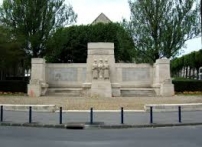| First Name: | Edward John | Last Name: | DICE | |
|---|---|---|---|---|
| Date of Death: | 27/05/1918 | Lived/Born In: | Wanstead | |
| Rank: | Private | Unit: | Middlesex2 | |
| Memorial Site: | Soissons Memorial, France | |||
Current Information:Enlisted-Leyton
On 27th May, 1918, the Germans launched their third major offensive of the year, this time against the French Army in its positions along the Chemin des Dames, between Soissons and Reims. This was supposed to be a quiet front and that was why four badly damaged British divisions, the 8th, 21st, 25th and 50th, had been sent there so they could recover from the mauling they had taken during the previous two German offensives of that year. Formed into IX Corps, in early May they took over a 10 mile section of the front, just to the west of Reims including part of the Chemin des Dames. Like the two earlier offensives, Operation Blücher on 27th May began with a ferocious artillery bombardment, carefully orchestrated to cause maximum confusion and damage and, as in March and April, enormous gains were made as the Germans drove a wedge forty miles wide and fifteen miles deep through the Allied lines. For over a week they continued the advance. Paris was threatened but once again their attack ran out of steam while French resistance strengthened and by 6th June the front had been stabilised. The opening artillery bombardment at 1am on 27th May was heavier and more destructive than those experienced by the British Army either in March or April. It was simply devastating, made so by the liberal use of gas shells, interspersed with shrapnel and high explosive. All the rear areas, lines of communication, command centres and artillery positions, were targeted as were the trenches of the Forward and Battle Zones. The 21st, 8th and 50th Divisions who held the front line with all three of their brigades were simply blown away by the magnitude of it all. When the German storm troopers burst into their trenches at 3.40am nearly all resistance had crumbled. Those who survived the shelling were still sheltering in their dug-outs and were easily overcome. Some heroic stands were made and some troops managed to fall back to positions in the rear but in effect the three divisions had ceased to exist by dawn. 8th Division, in the centre of the British line had nine weak battalions and were attacked by twenty one fresh German battalions. On the left of the divisional front, 23 Brigade had 2nd West Yorkshire in the front line and 2nd Middlesex occupying a line of redoubts behind them, in front of the Battle Zone. Despite the incredible pressure 2nd West Yorkshire managed to hold up the German advance, but not for long . Between 5am and 6am, aided by the early morning mist, the Germans had penetrated both sides of the Redoubt line and the situation became hopeless. 2nd Middlesex were overwhelmed and only two officers and twenty one men got away. This small party stood guard on the three bridges crossing the Aisne Canal and its Canal, south of Pontavert, until they were blown by Royal Engineers and they then fell back to Roucy and later to Montigny. Among the many casualties suffered by 2nd Middlesex was Edward Dice. |
||||
| « Back to Search Results | ||||
| If you think any of the information shown here is incorrect, Click Here to submit your amends and comments | ||||




